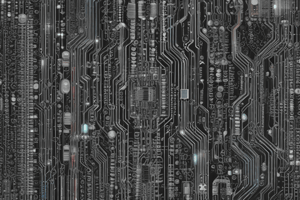Podcast
Questions and Answers
What is the function of an AND gate in a digital circuit?
What is the function of an AND gate in a digital circuit?
- Outputs a 1 when the input is 0
- Inverts an input signal
- Produces a 1 output if any of the inputs are 1
- Produces a 1 output only when both inputs are 1 (correct)
What is the primary role of digital logic in electronics and hardware?
What is the primary role of digital logic in electronics and hardware?
- Converting digital signals to analog signals
- Processing and manipulating binary data using logic gates (correct)
- Generating random binary data
- Creating analog signals
Which type of logic circuit has its output dependent only on the current input values?
Which type of logic circuit has its output dependent only on the current input values?
- Parallel logic circuit
- Analog logic circuit
- Sequential logic circuit
- Combinational logic circuit (correct)
What is the key function of an OR gate in a digital circuit?
What is the key function of an OR gate in a digital circuit?
What type of circuits perform basic arithmetic operations like addition and subtraction?
What type of circuits perform basic arithmetic operations like addition and subtraction?
Which circuits compare two binary values to determine if they are equal or different?
Which circuits compare two binary values to determine if they are equal or different?
What type of circuits decode binary codes into individual signals?
What type of circuits decode binary codes into individual signals?
Which type of circuits convert multiple signals into a single binary code?
Which type of circuits convert multiple signals into a single binary code?
What are flip-flops and latches used for in sequential logic circuits?
What are flip-flops and latches used for in sequential logic circuits?
What led to the miniaturization of digital logic circuits and the reduction in size and cost of digital electronics?
What led to the miniaturization of digital logic circuits and the reduction in size and cost of digital electronics?
Flashcards are hidden until you start studying
Study Notes
Exploring Electronics and Hardware: Unraveling the Mystery of Digital Logic
Electronics and hardware form the backbone of modern technology, enabling a plethora of devices that we often take for granted. At the heart of these systems lies the fascinating world of digital logic, which we'll delve into in this comprehensive exploration.
Digital Logic: The Core of Electronics and Hardware
Digital logic is the branch of digital electronics that focuses on processing and manipulating binary data using logic gates. These gates construct networks that perform logical operations, such as AND, OR, and NOT, transforming input signals into output signals based on simple rules.
Logic Gates
Logic gates are the building blocks of digital circuits. They are electronic components that accept binary inputs (either 0 or 1) and produce a binary output based on the input values. The three most common logic gates are:
-
AND Gate: This gate produces a 1 output only when both inputs are 1. If either or both inputs are 0, the output is 0.
-
OR Gate: This gate produces a 1 output if any of the inputs are 1. If both inputs are 0, the output is 0.
-
NOT Gate: This gate inverts an input signal: it outputs a 1 when the input is 0, and a 0 when the input is 1.
Combinational Logic
Combinational logic circuits are digital circuits where the output is directly dependent on the current input values. By combining logic gates, these circuits can perform complex calculations and decision-making processes.
Some common combinational logic circuits include:
-
Decoders: These circuits decode binary codes into individual signals.
-
Encoders: These circuits convert multiple signals into a single binary code.
-
Arithmetic circuits: These circuits perform basic arithmetic operations like addition and subtraction.
-
Comparators: These circuits compare two binary values to determine if they are equal or different.
Sequential Logic
Sequential logic circuits, on the other hand, have outputs that depend on both the current input values and the previous state (or internal memory) of the circuit. Sequential circuits can be found in devices such as counters, registers, and shift registers, which allow data storage and manipulation.
Sequential Logic Elements
Sequential logic circuits often use flip-flops and latches, which are devices that store a single bit of information. Flip-flops, such as JK flip-flops and D flip-flops, are synchronous devices, meaning their outputs change only upon receiving a clock signal. Latches, such as SR latches, store a bit of information but do not require a clock signal to change their output.
The Rise of Integrated Circuits
The advent of integrated circuits (ICs) led to the miniaturization of digital logic circuits. ICs combine thousands of transistors, diodes, resistors, and capacitors into a single chip, greatly reducing the size and cost of digital electronics. Modern microprocessors and digital circuits, including the components used in smartphones, computers, and robotics, owe their existence to the marvel of integrated circuits.
Conclusion
Understanding digital logic is the key to comprehending the inner workings of electronics and hardware. By studying the behavior of logic gates, combinational logic circuits, and sequential logic circuits, we can appreciate the complexity and ingenuity that goes into the creation of modern technology.
As we delve deeper into the fascinating world of digital electronics, we can marvel at the intricacies of digital logic and appreciate the impact these circuits have on our daily lives. The future of digital electronics looks bright: with the continued miniaturization of circuits and the rise of new technologies such as the Internet of Things (IoT) and Artificial Intelligence (AI), the possibilities for innovation are virtually limitless.
Studying That Suits You
Use AI to generate personalized quizzes and flashcards to suit your learning preferences.




